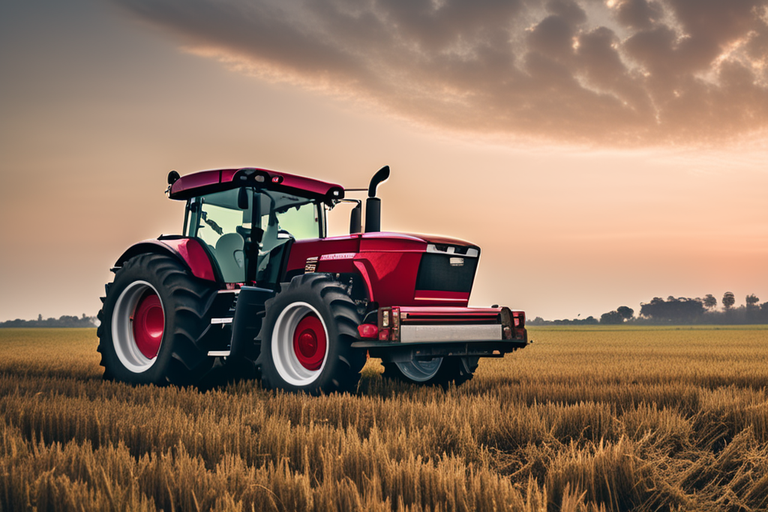A tractor is a type of commercial vehicle designed specifically to transport heavy loads at slow speeds, such as trailers and other farm equipment used in construction or agriculture. Tractors make it easier for engineers, builders, farmers, landscapers, and others to work the land around them in the contemporary agricultural era. In addition to regular yard care, landscape maintenance, fertiliser movement or spreading, and bush clearance, modern tractors are utilised for planting, tilling, and ploughing fields. Tractors provide a variety of benefits to farmers and cultivators for routine lawn and garden maintenance as well as on small farms. Fieldwork would become increasingly difficult on a daily basis without the use of tractors.
Nonetheless, depending on the automotive industry, the word “tractor” can have different connotations for individuals who are not involved in farming.
With a wealth of knowledge in the field of agricultural machinery, we can help you. We can provide you with the information you need to choose the ideal machine for your company and reduce the cost of buying new equipment. We can successfully advise our customers and help them save money by utilising our manufacturer discount structures and procedures, knowledge of expert reviews and their recommendations, and our ability to save money while choosing the right machine!
Table of Contents
Top Tips to Get the Best Tractor for Your Farms
The buyer must first choose the type of tractor that best matches the tractor they currently own, whether it be a utility, loader, or garden tractor. Numerous popular tractor types are described by the types listed below:
Evaluate Your Requirements
Consider your needs carefully and take a step back before you visit dealerships or start looking through catalogues. Think about the tasks you need the tractor to complete, the size of your farm, and the terrain you work on. Do you mostly work in heavy load hauling, tilling, or ploughing? Do you need any extra attachments like a backhoe or front-end loader? Making a more informed choice and reducing your options will be made easier if you know what you need.
Establish a Budget
Establish a budget in advance. This is a useful tool for narrowing down your options. However, it would help if you didn’t base your decision solely on this. You should consider extending your budget a little bit if you discover a tractor that meets all the other requirements listed above. It is important to consider the resale value of any farm equipment you purchase, including tractors, as you may wish to upgrade your equipment in the future. Many band tractors are budget friendly like the Mahindra 265 DI XP Plus price is affordable.
Front loaders and lift capacities
In the industry, lift capacity is arguably the least accurate metric to determine a tractor’s existence. The number given is frequently different from the actual weight that the tractor can lift, whether it is the loader’s lift capacity or the three-point lift.
It is advisable to purchase a loader that performance matched to a specific model of tractor from the same manufacturer. There is a trade-off between speed and actual lift capacity. A front loader with a slow cycle time is likely to lift a weight that is quite heavy.
Wheel Drive
When used with a front loader, we advise most tractors with engines under 50 horsepower to have four-wheel drive. This is because the tractor’s front wheels will buried in any soft or wet ground, resulting in a noticeable loss of traction. This caused by the additional weight placed over the tractor’s front. An unsafe condition will result from a sinking front end, even in well-balanced two-wheel drive tractors. Additionally, a tractor rollover could occur if one of the front wheels sinks more than the other, producing an unbalanced load. In addition, four-wheel drive tractors have wider tyres, which result in a larger footprint that is less resistant to losing traction and turning.
The power-steering system of a two-wheel drive tractor with a front loader will also subjected to undue strain, as most small tractors lack the necessary strength to turn the wheels efficiently in soft ground conditions. Lastly, early wear will result from the front axle kingpin and pivot points bearing a heavy load due to the front loader’s increased weight. The front end of a tractor with four wheels will pull itself, reducing the chance of losing traction.
Value at Resale
“The sweetness of a low price quickly followed by the bitterness of poor quality.”
Keep in mind that everything you purchase will eventually need to sold. Purchasing a tractor from a “name brand” will ensure that you won’t have any problems finding your equipment in a new home in the future. A tractor will be more in demand in the used market if its current nationwide market-share is higher than that of other manufacturers.
Consult an Expert
Always be bold and ask professionals in the field for advice. Speak with knowledgeable farmers, agricultural extension agents, or tractor specialists who can offer insightful advice based on their experience and knowledge. They can assist you in comprehending the technical details, point you in the direction of the appropriate attachments, and make recommendations based on your particular farming needs. Their knowledge can be very helpful in helping you make a wise choice.
Guarantee and Post-Purchase Assistance
Examine the manufacturer’s warranty carefully before completing your purchase. You can have peace of mind and protection against unforeseen repair costs with a comprehensive warranty. Ask about the availability of service facilities, replacement parts, and technical support in addition to after-sales support. An attentive and effective after-sales support system can substantially improve your experience as a homeowner.
These are all about A Guide to Buying a Tractor in India. For information about the Mahindra Yuvo 575 price, stay connected with us.

